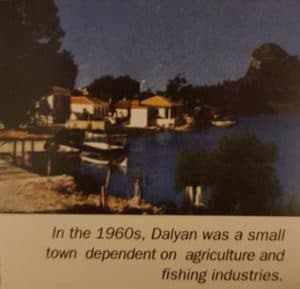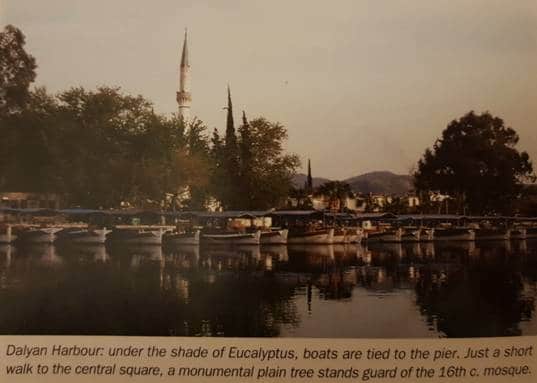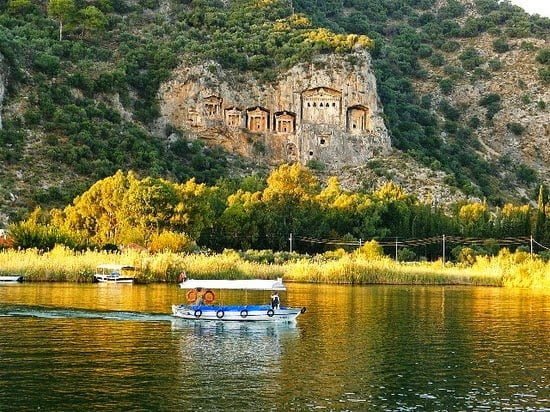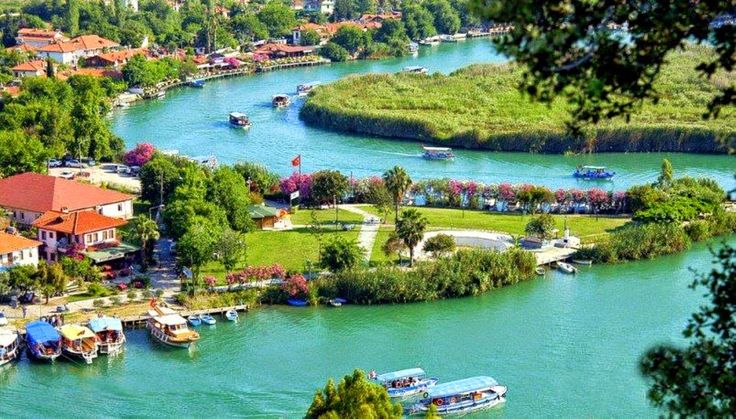 The town of Dalyan has a history that probably dates back to the 13th century, but which received it’s status technically speaking during Süleyman the Magnificent’s Rhodes campaign. More recently, about 30 to 40 years ago, this settlement turned village was almost exclusively dependent on agriculture and fishing for its sustenance.
The town of Dalyan has a history that probably dates back to the 13th century, but which received it’s status technically speaking during Süleyman the Magnificent’s Rhodes campaign. More recently, about 30 to 40 years ago, this settlement turned village was almost exclusively dependent on agriculture and fishing for its sustenance.
Then in the 1980’s Dalyan saw a quick rise in tourism as word got out that this forgotten jewel was situated right in the middle of one of the world’s most rare and bountiful ecosystems. To be in this splendid corner of nature which took thousands of years to develop while facing the ancient city of Caunos is indeed an unforgettable experience. Geography, flora & fauna and history offer a bouquet of Dalyan attractions. An earthly paradise…

The first time I came to Dalyan was in the 1970s, as an archeology student taking part in an excavation at Caunos; a treasured and memorable experience for me. Back then, the wharf moored only 10 to 15 boats and the ruins of an Ottoman bath stood right behind the 16th century mosque, which was the last remaining trace of its antique past. There were just a few shops surrounding the square in the shadow of the sublime plane tree in front of the mosque. The quiet life of a Mediterranean village under the parching sun held sway over the narrow dirt roads along which mostly single-storied houses in garden lots were built.
In those years it was very difficult to reach Dalyan, which was off the main highway. To get there, one could either take a taxi-boat from Köycegiz (if the weather was good) or by way of a narrow dirt road via Ortaca. Once you got to Dalyan you would be enchanted by its remarkable flora, fauna and famed relics of antiquity. This magical environment had attractions that would render its visitors spell-bound and which personally held me captive, requiring many, happy returns over an extended period of time, starting back on a September evening in 1970.
Taking a rest to shed off the dust from the long road I had to walk from Ortaca to Dalyan due to lack of transport, I was shaken with a mystical admiration for the magnificence of the rock tombs and Acropolis, the haunting beauty of the water, the reeds and the pine forests. While the thin white clouds hanging on the high hills were set on fire by the sunset, a resplendent white star rose above the ancient walls of the Acropolis. This was Venus, the Latin name for Aphrodite, who bestowed wishes of “bon voyage” and “good fortune” to ships departing from the Caunos Harbour. It was here long ago, near the Agora stoa that her devotees built a sacred chamber in her honour. The Goddess of Love could then meet future visitors to Dalyan with promises of happiness.

Dalyan Attractions:
After the 1980s the Dalyan in my memories developed like a pearl, turning itself into a world famous tourism centre. Registered as a Natural Reserve in 1988, it was saved from uncontrolled housing development and population growth. Thankfully, the ecosystem consisting of the Köyceğiz Lake, the Dalyan River, the Delta and Iztuzu Beach maintain a status of preserved abundance. In other words, it is a bouquet of wonders…
Situated in the midst of a rare ecosystem, Dalyan is not a seaside town, but it has both one of the most beautiful beaches in the world nearby, a unique delta and its four lakes, such as Sulungur, Tuz Lake and Alagöl that are all situated on the Delta. The ancient city of Caunos, the history of which dates back to the 1st millenium BC, is just across the river. Ruins from a wandering wall that once defended the old city, rises and falls along the steep gradient that holds the terraced Acropolis. Monumental tombs belonging to noble families of Caunos are also found here, carved deeply into a steep cliff of limestone, modeled from temple façades. The bouquet of Dalyan attractions invite lovers of nature, history and archaeology to return time and time again.
TIP: You can find many other articles about Dalyan and Dalyan Attractions on here on our Guide pages.

Source: Koycegiz – Dalyan A Journey Through History Within The Labyrinth of Nature, (pages: 44-47), Altan Türe, 2011, Faya Kültürel Yayınları


Comments